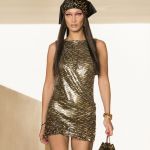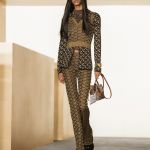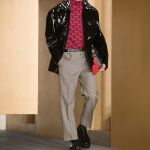
Versace's new wave
The brand restarts with a renovated aesthetic and an unprecedented pattern
March 5th, 2021
With the latest FW21 show, the turning point for Versace has arrived. A revolution conveyed by the House's new monogram – monogram that should replace the Greek and Baroque patterns for which the brand has become famous so far, bringing it to the same level as brands such as Dior, Gucci and Louis Vuitton.
Along with the new pattern, however, a new mood has also landed at Versace, which has finally left behind fireworks of patterns and colours to create a collection dominated by the formal look, very focused on clean silhouettes and products that suggest the idea of more discreet luxury. In general, the feeling is that the creative team has finally detached from the old imagery of the brand (the golden studs, the silks printed with Baroque fantasies, the hyper-logoed and soulless maximalism) and, starting from scratch with the new pattern, has created a much more modern look, much more coherent and above all that doesn't change the identity of the brand.
As mentioned, the essential vehicle of this change of course is the new pattern. A brand such as Louis Vuitton, for example, is estimated to get 45% of operating profitability from its monogrammed line of accessories. The same importance has the same lines for Gucci, Chanel, Hermès and Dior. It's also true that, in the past, both Burberry and Ferragamo have tried to relaunch new monograms but without achieving entirely satisfactory results. It then explains why Versace's new collection introduced the monogram (present in almost every look) together with a change of aesthetics, which has now become decidedly more mature. Meanwhile, after a 55% acceleration in sales stopped last February with the lockdown, the brand's sales began to restart in the summer in the last quarter of 2020 with online sales doubling. Sebastian Manes, Buying & Merchandising Director at Selfridge's, explained to Business of Fashion:
Currently, the brand has two different clients — there’s the couture client who really wants to make to make a statement, then you have the Gen-Z and Millennials who just want access to the brand at an accessible price. It’s great that they’ve managed to seduce this young clientele, but the question after that is how can they up-sell?
The new collection would seem to be the answer to this question. Versace's problem (if such a prosperous brand can have problems) has always been the discrepancy between brand awareness and actual sales. Capitalizing on this awareness and closing the gap with sales is the mission of a new collection that addresses a more transversal audience with items that can attract both the younger generations thanks to social media buzz and a more mature clientele, and also thanks to a more discreet and rationalized vision, which has abandoned, as we said, the traditional armament of superficial luxury made of screaming colours, huge branding, and, in general, the chaotic energy brought to the brand by flirting with streetwear codes – codes that finally seem to have been, if not abandoned, at least pleasantly scaled in favour of new linearity and a new freshness.



















































































